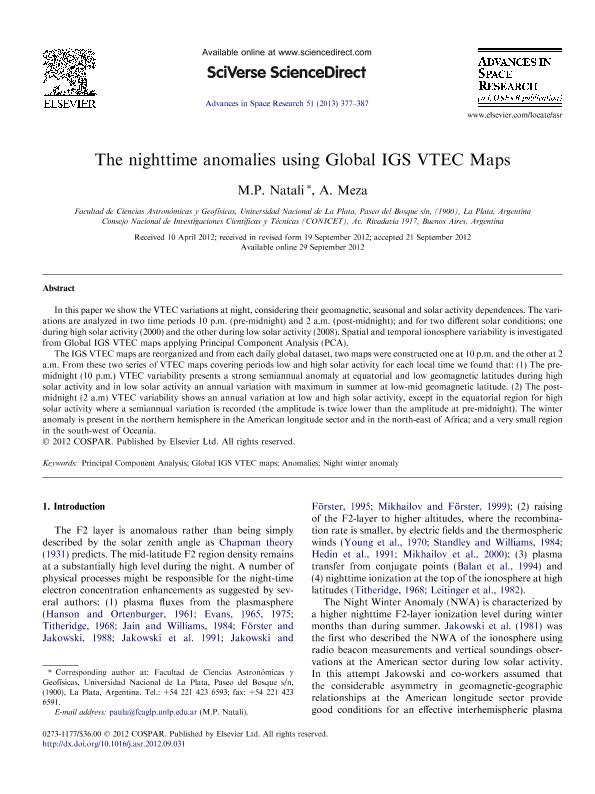Mostrar el registro sencillo del ítem
dc.contributor.author
Natali, Maria Paula

dc.contributor.author
Meza, Amalia Margarita

dc.date.available
2019-05-22T16:40:28Z
dc.date.issued
2013-02
dc.identifier.citation
Natali, Maria Paula; Meza, Amalia Margarita; The nighttime anomalies using Global IGS VTEC Maps; Elsevier; Advances in Space Research; 51; 3; 2-2013; 377-387
dc.identifier.issn
0273-1177
dc.identifier.uri
http://hdl.handle.net/11336/76860
dc.description.abstract
In this paper we show the VTEC variations at night, considering their geomagnetic, seasonal and solar activity dependences. The variations are analyzed in two time periods 10 p.m. (pre-midnight) and 2 a.m. (post-midnight); and for two different solar conditions; one during high solar activity (2000) and the other during low solar activity (2008). Spatial and temporal ionosphere variability is investigated from Global IGS VTEC maps applying Principal Component Analysis (PCA). The IGS VTEC maps are reorganized and from each daily global dataset, two maps were constructed one at 10 p.m. and the other at 2 a.m. From these two series of VTEC maps covering periods low and high solar activity for each local time we found that: (1) The pre-midnight (10 p.m.) VTEC variability presents a strong semiannual anomaly at equatorial and low geomagnetic latitudes during high solar activity and in low solar activity an annual variation with maximum in summer at low-mid geomagnetic latitude. (2) The post-midnight (2 a.m) VTEC variability shows an annual variation at low and high solar activity, except in the equatorial region for high solar activity where a semiannual variation is recorded (the amplitude is twice lower than the amplitude at pre-midnight). The winter anomaly is present in the northern hemisphere in the American longitude sector and in the north-east of Africa; and a very small region in the south-west of Oceania.
dc.format
application/pdf
dc.language.iso
eng
dc.publisher
Elsevier

dc.rights
info:eu-repo/semantics/openAccess
dc.rights.uri
https://creativecommons.org/licenses/by-nc-sa/2.5/ar/
dc.subject
Anomalies
dc.subject
Global Igs Vtec Maps
dc.subject
Night Winter Anomaly
dc.subject
Principal Component Analysis
dc.subject.classification
Meteorología y Ciencias Atmosféricas

dc.subject.classification
Ciencias de la Tierra y relacionadas con el Medio Ambiente

dc.subject.classification
CIENCIAS NATURALES Y EXACTAS

dc.title
The nighttime anomalies using Global IGS VTEC Maps
dc.type
info:eu-repo/semantics/article
dc.type
info:ar-repo/semantics/artículo
dc.type
info:eu-repo/semantics/publishedVersion
dc.date.updated
2019-05-14T21:08:14Z
dc.journal.volume
51
dc.journal.number
3
dc.journal.pagination
377-387
dc.journal.pais
Países Bajos

dc.journal.ciudad
Amsterdam
dc.description.fil
Fil: Natali, Maria Paula. Consejo Nacional de Investigaciones Científicas y Técnicas. Centro Científico Tecnológico Conicet - La Plata; Argentina. Universidad Nacional de La Plata. Facultad de Ciencias Astronómicas y Geofísicas; Argentina
dc.description.fil
Fil: Meza, Amalia Margarita. Universidad Nacional de La Plata. Facultad de Ciencias Astronómicas y Geofísicas; Argentina. Consejo Nacional de Investigaciones Científicas y Técnicas. Centro Científico Tecnológico Conicet - La Plata; Argentina
dc.journal.title
Advances in Space Research

dc.relation.alternativeid
info:eu-repo/semantics/altIdentifier/doi/http://dx.doi.org/10.1016/j.asr.2012.09.031
dc.relation.alternativeid
info:eu-repo/semantics/altIdentifier/url/https://www.sciencedirect.com/science/article/pii/S0273117712006217?via%3Dihub
Archivos asociados
